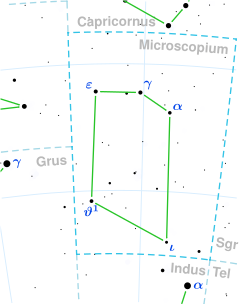| Observation data Epoch J2000.0 Equinox J2000.0 (ICRS) | |
|---|---|
| Constellation | Microscopium |
| Right ascension | 21h 13m 03.06827s[1] |
| Declination | −39° 25′ 29.7097″[1] |
| Apparent magnitude (V) | 5.26[2] |
| Characteristics | |
| Spectral type | F5 IV-V[3] or F6 V Fe−0.9 CH−0.5[4] |
| B−V color index | +0.44[2] |
| Astrometry | |
| Radial velocity (Rv) | −41±1[5] km/s |
| Proper motion (μ) | RA: +185.855 mas/yr[1] Dec.: −113.449 mas/yr[1] |
| Parallax (π) | 29.2823 ± 0.0827 mas[1] |
| Distance | 111.4 ± 0.3 ly (34.15 ± 0.10 pc) |
| Absolute magnitude (MV) | +2.66[6] |
| Details | |
| Mass | 1.5[1] M☉ |
| Radius | 2.18±0.09[7] R☉ |
| Luminosity | 7.83±0.04[1] L☉ |
| Surface gravity (log g) | 3.91±0.09[8] cgs |
| Temperature | 6,519±80[9] K |
| Metallicity [Fe/H] | −0.18±0.03[10] dex |
| Rotational velocity (v sin i) | 10[11] km/s |
| Age | 2.23±0.04 Gyr |
| Other designations | |
| Database references | |
| SIMBAD | data |
HD 201772, also known as HR 8104, is a yellowish-white hued star located in the southern constellation Microscopium. It has an apparent magnitude of 5.26,[2] making it one of the brighter members of this generally faint constellation. The object is located relatively close at a distance of 111 light-years based on Gaia DR3 parallax measurements[1] but is approaching closer with a heliocentric radial velocity of −41 km/s.[5] At its current distance, HD 201772's brightness is diminished by 0.11 magnitudes due to interstellar dust.[14]
The star has been given multiple stellar classifications over the years. It was given the luminosity class of a subgiant and main sequence star (IV/V; IV-V)[15][3] and a dwarf (V).[16][17] Most sources generally agree that it is a F5 star. Richard O. Gray and colleagues give HD 201772 a class of F6 V Fe−0.9 CH−0.5, which indicates that it is a F-type main-sequence star with an underabundance of iron and CH molecules in its spectrum.[4]
It has 1.47 times the mass of the Sun[18] and an enlarged radius of 2.2 R☉.[7] It radiates 7.8 times the luminosity of the Sun from its photosphere at an effective temperature of 6,519 K.[9] At an age of 2.5 billion years, HD 201722 is currently 1.33 magnitudes above the ZAMS, consistent with a star that is evolving off the main sequence.[11] The star has an iron abundance 66% that of the Sun,[10] making it metal deficient. It spins modestly with a projected rotational velocity of 10 km/s.[11]
HD 201772 is suspected to be a spectroscopic binary consisting of the subgiant described above and an ordinary F6 V star with a mass of 1.31 M☉.[19] However, the stars have no separation or an orbital period.[20] This is because the companion might be a result of spectrum contamination, so HD 201772 is more likely to be a solitary star.[21]
- ^ a b c d e f g Cite error: The named reference
GaiaDR3was invoked but never defined (see the help page). - ^ a b c Cite error: The named reference
Corben1968was invoked but never defined (see the help page). - ^ a b Cite error: The named reference
Gray1989was invoked but never defined (see the help page). - ^ a b Cite error: The named reference
Gray2006was invoked but never defined (see the help page). - ^ a b Cite error: The named reference
Gontcharov2006was invoked but never defined (see the help page). - ^ Cite error: The named reference
Anderson2012was invoked but never defined (see the help page). - ^ a b Cite error: The named reference
Masana2006was invoked but never defined (see the help page). - ^ Cite error: The named reference
Stassun2019was invoked but never defined (see the help page). - ^ a b Cite error: The named reference
Casagrande2011was invoked but never defined (see the help page). - ^ a b Cite error: The named reference
Netopil2017was invoked but never defined (see the help page). - ^ a b c Cite error: The named reference
Nordstrom2004was invoked but never defined (see the help page). - ^ Cite error: The named reference
Gould1879was invoked but never defined (see the help page). - ^ Cite error: The named reference
SIMBADwas invoked but never defined (see the help page). - ^ Cite error: The named reference
Gontcharov2017was invoked but never defined (see the help page). - ^ Cite error: The named reference
Adams1935was invoked but never defined (see the help page). - ^ Cite error: The named reference
Malaroda1975was invoked but never defined (see the help page). - ^ Cite error: The named reference
Houk1982was invoked but never defined (see the help page). - ^ Cite error: The named reference
Feltzing2001was invoked but never defined (see the help page). - ^ Cite error: The named reference
Tokovinin20141was invoked but never defined (see the help page). - ^ Cite error: The named reference
Tokovinin20142was invoked but never defined (see the help page). - ^ Cite error: The named reference
Eggleton2008was invoked but never defined (see the help page).
